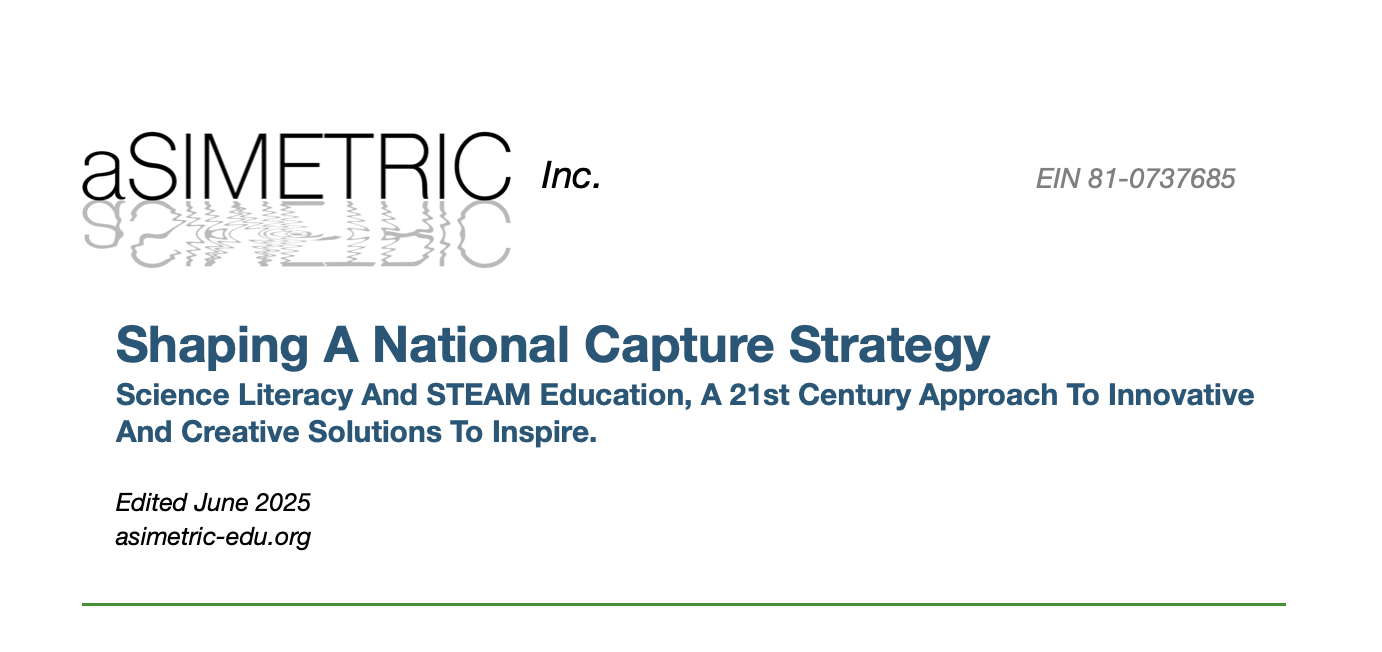Science Literacy, via Emotional Engagement For The 21st Century
aSIMetric is a 501(c)(3) nonprofit focused on creative solutions to better engage children, and the public, in science based activities. Specifically targeting emotional engagement, scalable programs accessible within population centers and local communities.

aSIMetric
501(c)(3) - EIN 81-0737685
aSIMETRIC’s Mission statement: We are pioneering an entertainment-centric, long-term strategy to engage the public in science literacy and informal STEAM education.
WATCH: Short video discussing the basic premise of aSIMetric.
LISTEN: An AI generated podcast style intro to aSIMetric:
READ: Long Form PDF For Download
Why aSIMetric Formed:
The 3 Challenges:
There are three persistent challenges, to STEM education, and encouraging science literacy, consistently referenced in conversations with educators and industry alike. aSIMmetric was formed around finding solutions to these three challenges.
-
This is critical. The future of education is better understanding the emotional bedrock that motivates learning. In the words of Arthur C. Clark, "when children are interested, education happens." Shaping that inical interest is a priority. Todays informal institutions, designed to captivate and inspire, are the product of a 30 year old strategy. Mostly information presentation with limited interaction.
-
There is a phenomena known as single event exposure. Children exposed to these programs and institutions indeed may experience an initial burst of inspiration from a program or visit. But without follow-up, this excitement quickly fades. Sustained interaction is crucial to nurture that initial spark into a lasting passion and cultivate lifelong learners.
-
In support of national education, traditional informal STEM institutions like science centers and museums, while valuable, face limitations. Their centralized locations require travel, restricting reach, and their high operating costs create further barriers. They struggle to achieve the required cultural penetration.

Our Solution:
Deep Skies Project:
A Future Focused Aerospace Simulation Program To Inspire.
A simulated Aerospace experience (combined aviation/space exploration) provides a set of solutions to the three main challenges above. Our project is simulating a near future aerospace career. As a team of four crew members, with a high-fidelity modelled vehicle and experience. Designed to maximise the number of STEM based topics being engaged. Focused on immersion and high-fidelity simulation within an open-ended sandbox universe, as a tool to nurture interest, via an entertainment system, enabling a capture strategy in support of national education.
Why An Aerospace Approach Works:
-
aSIMetric’s entertainment-centric approach is designed to capture that initial interest. Children are tough customers, entertainment provides the competitive edge in a world competing for our children’s attention. We need a unique solution, with unique architecture, we need Decisive Impact And Emotional Engagement. To be able to compete, aSIMetric is engineering an immersive, high-fidelity aerospace simulation, combining aviation and space exploration into a single experience. A high impact engaging and memorable informal learning experiences. An experience designed to maximise emotional engagement. An engineered tool, using the well understood phenomena of entertainment, as our Trojan horse, to broaden the catch net, and encourage more young people to engage.
-
aSIMetric understands it is about the experience, an experience that is truly immersive. Sight, sound, touch and smell, in a fully immersive tactile and kinetic environment. This is collaboration between engineering and art. The hardware and corresponding software form the technical crux of the commercial program. The motion platform would be used to simulate both atmospheric flight and orbit, accentuating manoeuvres such as acceleration and deceleration. The next component to consider is the cabin and flight deck. Everything that happens, the entire mission architecture, has to happen from that flight deck. The internal environment requires a good level of fidelity to create a full, immersive, tactile experience; it needs to look, feel and sound as close to reality as possible. An experience made all the more meaningful, if we incorporate a social, or team based, design element. The simulator is built around a team, or flight crew, of four. This gives us a shared experience, between friends or family members. Unlike VR experiences designed around the individual, our classroom of the future is VR built around a team layers of immersion. An adventure played out in a virtual sandbox universe providing great depth, enabling long-term engagement, shaping virtual career options. A system that allows the team to write the story of how they, as a team of four friends, explored and conquered the universe. It is a narrative soaked in experience, lessons hard-learned, battles lost and won.
-
Instead of traditional, large-scale centralised institutions, we envision a compact, easily maintained, and cost-effective distributed system. This allows us to scale down on costly infrastructure while scaling up virtual, and interactive experiences. Our compact system can be deployed in various population centers, overcoming traditional barriers of travel and cost. This greatly increases accessibility for the public and children that often don’t get these opportunities. This shifts from the focus, of large informal STEM institution, from high passthrough, high-volume of visitors and "hope something sticks" approach, to a more focused, emotionally engaging strategy. Particularly well-suited for smaller population centers. Reduced passthrough, but with more impactful content, aSIMetric aims for a greater probability of meaningful engagement. Servicing numerous population centers with our flexible and versatile approach will ultimately lead to more effective distributed passthrough and greater cultural penetration over time.
-
Aviation and space exploration inherently captivate the public's imagination, offering an unparalleled gateway to a vast array of STEM topics. Through aerospace simulation, we can transform abstract scientific concepts into tangible, physical experiences. The future potential of space exploration, particularly its impact on youth, is often underestimated. The Space Race of the 1960s and 1970s, for example, ignited a massive educational boom in the United States. This era saw a threefold increase in STEM-related PhDs, not primarily due to educational policy, but because the public witnessed engineers dreaming, building, and achieving the seemingly impossible. People were profoundly inspired. As humanity prepares to return to the Moon and venture into deep space, a new era of inspiration is dawning. We all stand to benefit significantly as these real-world events influence younger generations. The future will see a generation motivated and inspired. We need mature programs ready to accommodate and capture that potential. With the advent of space tourism, the commercialization of space, and humanity's push beyond low Earth orbit, the next chapters in our history are rapidly approaching. Should we fail to have capable and mature capture strategies in place, waiting to accept the firestorm of enthusiasm that will follow, then we deserve the harshest judgment history will arrange.
-
Aerospace provides a golden opportunity as a capture strategy. A Capture, Hold, Connect approach, reimagined for the 21st century, converting visitors into active participants, an important distinction. The 'capture' component is the entertainment interface with the public. Unlike most informal STEM programs like coding or robotics, aSIMetric leans in to entertainment to widen the catch net and not just preach to the fan base. Hold, or nurture is the implementation of long-term programs leaning on narrative, long term distant goals, always just out of reach. A unique team based adventure to distant worlds and discoveries. On the back end of our capture strategy are the ecosystems that dovetail with formal and informal education organizations across a given nation. aSIMetric is designed as both a capture strategy and a local STEAM education resource, requiring and facilitating broad community ecosystems. aSIMetric understands that quality science learning is best supported through a robust cohesive community-wide ecosystem. It is not a stand-alone program, gone are the days we work alone, the STEAM community is a team effort.
-
Inspired by Professor Sugata Mitra's 'Hole in the wall’ experiments, first carried out in 1999, and his teams work into SOLEs, Self-organizing learning environments. We understood self learning and discovery are powerful educational strategies.
Further studies, based on these surprising experiments, found that such self-learning principles, gave rise to deep learning. Those students invested in the experience, and the process of discovery, rather than being taught traditionally, showed the children retained the knowledge better. Follow on experiments concluded that there are many ways education can be effective, outside the state education system, and the importance of self-learning and self-organization can lead to emergent properties with very positive results.
Professor Mitra, later optimized classroom conditions, to encourage effective self-learning environments. Confirming that children in small groups, of four to six, proved optimal. This approach, produced what were referred to as SOLEs, Self-organizing learning environments. Many, such programs were established in classrooms around the world. However, these approaches are not easily applicable, to state school curriculums. As such, the concept was not widely adopted. It became clear, very quickly, the difficulty working with state education. This led to the aSIMetric team forming an informal educational program, as a nonprofit.
We view our flight decks and cabins as classrooms of the future. Many elements, of Professor Mitra’s work, played a prominent role, in shaping our ideas. New ways we might better engage children, with long-term, Informal entertainment-centric educational programs. We envision our simulated environments, optimised for a team of four students, as compact classrooms or SOLE’s.
Q. Our AI Future And Absolute Uncertainty?
A. It’s hard to predict, no one knows the timelines, and it feels overwhelming. Here’s what we can say; advances in coding, graphical interface, game development and simulation, will radically advance in the coming years at a mind bending speed we struggle to keep pace with.
Our solution is to focused on the physical component to compliment these advances. In order to create the required impact, you need the physical social experience. Then dovetail the flexible hardware with the latest software developments. Both these elements are required, insert your favourite Yin and Yang quote here…
aSIMetric is currently seeking partners, sponsors and support to fund a test and evaluation platform as the first step in the Deep Skies project.
-
TRL (Technology Ready Level) 1-2, is focus on hardware and simulation, understanding what is required to build and run an effective motion simulator. From building a basic static simulator to confirm the technical build (TRL-1) to applying motion (TRL-2).
This first phase would allow aSIMertic and stakeholders to assess a number of metrics and provide data that would steer the development of future builds. Including yet not exclusive to:
Identify unseen negative emergent properties.
Establish a lower age boundary (how young is too young)?
Crew interoperability (how a team of four work together within this environment)?
Cockpit crew interface and ergonomics.
Refine mission architecture.
Develop simulation procedures.
Phase one can be viewed as both a test and evaluation program and still operate as a standalone inspirational learning tool for informal education. This system would be tested with a limited number of test teams of various ages and backgrounds.
The engineering and building of the major components required to operate and includes enlisting help to run, maintain and develop the system, including local volunteer staffing.
Having established a reliable simulated flight deck and gathered the required data through testing, (TRL 3-4), we can evolve as an organisation through partnerships and funding developing a viable commercial program.
-
Dependent on the results of the test and evaluation platform. The proof of concept would see the construction and deployment of a commercially viable product. This includes methods of employment within local population centers, outside a test environment.
-
The strategic goal of aSIMetric is a commercially viable system of products, run by an organization capable of funding and scaling simulation centers in an expanding number of population centers nation wide.


